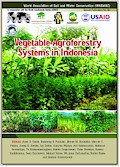| Book |
 |
|
| Title | Vegetable-Agroforestry Systems in Indonesia | | Editor | Anas D Susila, Bambang S. Purwoko, James M Roshetko, Manuel C. Palada, Juang G. Kartika, Lia Dahlia, Kusuma Wijaya, Arif Rahmanulloh, Mahmud Raimadoya, Tri Koesoemaningtyas, Herien Puspitawati, Tisna Prasetyo, Suseno Budidarsono, Iwan Kurniawan, Manuel Reyes, Wanraya Suthumchai, Karika Kunta and Samran Sombatpanit | | Year | 2012 | | Publisher | World Association of Soil and Water Conservation (WASWAC), Bangkok, Thailand and the World Agroforestry Center (ICRAF), Nairobi, Kenya | | City of Publication | Bangkok, Thailand | | Number of Pages | 362 | | Call Number | BK0161-12 | | ISBN | 978-974-350-655-0 |
|
| Abstract: |
| World population is about 7.09 billion (Levine, 2011) and is estimated
to increase by 101 million people per year. About 926 million people are hungry,
of whom 98% are in developing countries with Asia and the Pacific at
578 million (FAO, 2010). Furthermore, available resources such as land and
water have been rapidly diminishing. This project will seek to alleviate poverty,
food scarcity, and reduce environmental degradation in Southeast Asia
(SEA) by combining economically-viable and resource-conserving technologies,
and gender friendly socioeconomic policies that will benefit and reward
stakeholders in a watershed, especially small-scale farmers both women and
men (SSFWM). The hypothesis to be tested is, “integrating vegetable production in the agroforestry system on small farms will help to alleviate poverty
and enhance environmental protection, sustainability and ecosystem biodiversity
in SEA watersheds”. Another closely related hypothesis is, “integrating agroforestry in a vegetable production system on small farms will help to alleviate
poverty and enhance environmental protection, sustainability, and ecosystem
biodiversity in SEA watersheds. |
|